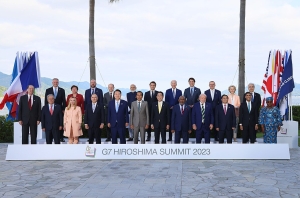Clean Energy Canada | Hurry, Canada, or we’ll miss out on the decarbonization revolution
June 5, 2023

Climate and energy were again high on the agenda at the recent G7 Summit following a record year of investment in clean energy. And with good reason: the member countries are home to 40 per cent of global GDP and a quarter of the world’s emissions, giving them enough collective economic clout to have a significant impact on the energy transition.
As the seven members navigate this transition, one area has popped up a lot in emissions-related discussions over the last couple of years: heavy industry. The sector — which includes steel, cement and chemicals — makes up about a quarter of global energy emissions.
In Canada, heavy industry’s share of emissions is a bit smaller at 11 per cent — still significant, but often overshadowed by the oil and gas sector’s headline-making 28 per cent share.
This year’s G7 Hiroshima Leaders’ Communiqué made numerous references to decarbonizing industry, including buyers clubs (where governments or private companies agree to collectively buy cleaner materials), data collection on emissions intensity, and the importance of developing the infrastructure for key technologies like hydrogen and carbon capture and storage.
And yet challenges remain beyond acknowledging the role and importance of these solutions. Many decarbonization approaches are still in their early stages of development and their cost can be a sticking point in a global and highly competitive market.
In response, many of our G7 peers are pouring billions into cutting carbon from their heavy industries. The U.S.’s Inflation Reduction Act offered a US$370-billion shot in the arm for clean energy and industrial transformation.
The European Union launched its Green Deal Industrial Plan, and countries including Germany, France, and Japan have launched multiple demonstration projects for near-zero steel and cement.
The investment isn’t simply an emissions imperative, it’s also an economic one. As global net-zero commitments mount, demand for cleaner products is increasing. The countries that act early stand to become leaders in a decarbonized future.
As our G7 counterparts charge ahead on industrial decarbonization, Canada must also act ambitiously or risk falling to the back of the pack, according to a new Clean Energy Canada white paper.
The good news is that Canada’s relatively clean electricity supply, existing world-class industries and educated workforce give it a built-in head start in the industrial decarbonization race.
Canada has also made a number of ambitious spending commitments, including $25 billion in federal government funding for cleaner fuels, technologies and businesses. Budget 2023 included investment tax credits for carbon capture and clean hydrogen. And Canada has already launched several near-zero technology demonstration projects.
What’s more, the federal government has stepped up on the world stage, actively participating in international standard-setting forums, such as the Industrial Deep Decarbonization Initiative. With increasing competition for green industries (think the battle to keep the Stellantis EV plant in Windsor), international standards can build a level playing field for Canada to compete with the U.S. and others.
However, Canada risks falling behind in three key areas.
First, in contrast to France, the U.K., and other countries, Canada does not have a clear, overarching strategy for industrial decarbonization, and only one sector (concrete and cement) has published a co-developed sectoral pathway to net zero. This could be a missed opportunity for co-ordinated action and for providing certainty to investors.
Second, our policies that address crucial demand-side gaps remain underdeveloped. In several G7 countries, governments are using their own buying power to create a market for cleaner industry. The U.S.’s new federal Buy Clean Initiative prioritizes the procurement of low-carbon steel, concrete, asphalt and glass, while the European Union’s Big Buyers for Climate and Environment supports local and regional governments in buying low-carbon materials. Canada is working on its own Buy Clean strategy, but the speed and scale of action remain lower than some G7 partners.
Finally, Canada needs to hone in on decarbonization activities like where they can create the most value, using our existing advantages, such as producing green hydrogen, leveraging our low-emitting electricity grid to rapidly electrify heavy industry processes, or using our existing expertise in the production of industrial chemicals and re-apply these skills and knowledge to produce low-carbon alternatives. Across the G7 countries, industrial decarbonization approaches focus on what each country does best, or where their natural resources provide a clear opportunity.
Budget 2023 took important steps forward, but there is still room for strategic policy and investment — such as building out our clean energy capacity and ensuring we have the infrastructure to deliver clean hydrogen and transport captured carbon.
Sweden, for example, has less than a third of Canada’s GDP but double the number of clean steel demonstration projects. It’s no coincidence it was a Swedish company that brought the first fossil-free steel to market in 2021.
With the net-zero transition accelerating around the world, we’re at a key juncture. If we make the right strategic decisions and investments in the coming years, Canada stands to be a hub for clean technologies and a leader in industrial decarbonization. But without clear visions and key policies in place, Canada risks trailing behind our biggest allies and trading partners.
This post was co-authored by Jana Elbrecht and originally appeared on Canada’s National Observer.